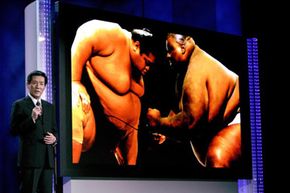Imagine that you have two copies of a movie and two television sets. One copy is on Blu-ray and you pair that with a high-definition television -- an HDTV. The other copy is on standard DVD, which you'll watch on a standard-definition television. You synchronize both videos and watch the results.
The difference in image quality between the two sets should be obvious. The HDTV's picture should look crisper and have colors far more vibrant than the standard counterpart. We've reached the peak of video quality -- or have we?
Advertisement
When we talk about HDTVs, we're really talking about image resolution. The picture on a television set is composed of millions of tiny dots of light called pixels. Standard-definition televisions have a resolution of 480. That means approximately 480 horizontal lines from the top of the screen to the bottom generate the images you see.
High-definition televisions pack more lines of pixels to create images. On the low end of the high-definition standard in the United States you have approximately 720 lines of pixels. On the high end, you have approximately 1,080 lines of pixels. Manufacturers are slowly phasing out the 720-line models in favor of the 1,080-line ones.
Using more pixels to create an image results in a smoother picture. Imagine you're given a stack of green and brown squares of paper. You're told you have to build a picture of a tree using the squares exactly as they are. If the squares of paper are large, your tree is going to look blocky with lots of jagged edges. But if you have smaller squares of paper, the tree will look smoother and more natural.
That's what high-definition television does. It's not just the number of pixels in the image -- it's the size of each individual pixel. As you pack more pixels into a screen, you have to make the pixels themselves smaller. In turn, the television will produce smoother images.
But is 1080 the best resolution possible? Could you buy a television set that packed even more pixels together? Would it make a difference? And would you be able to find programming that conformed to the higher resolution? Let's find out.
Advertisement


